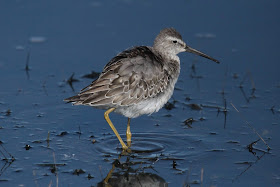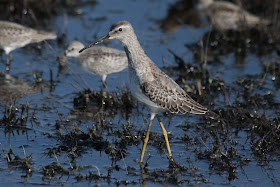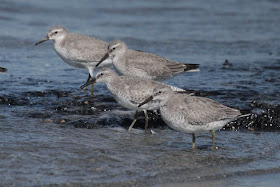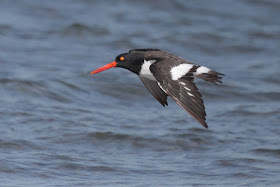With the summer shorebird species winding down slowy being replaced by the winter ones, a few exciting species dropped in with small numbers remaining for an extended stay offering generous looks. This being the last entry to my Late September Shorebirding quest now spilling over into October. Since Irene, I wanted to photograph as many species of Shorebirds as I could in New England.
For this report, I decided not to post a continuing written report, but instead to highlight these beautiful birds in an extensive photo string. I hope you enjoy these beautiful birds as much as I do.
After Irene left New England, many large puddles were formed in the fields at the western section of Hammonasset State Park; both from the heavy rains and the nine foot storm surge flooding and covering the lower areas. After the storm departed, these puddles remained being replenished by frequent rains. With the warm unseasonable temps of the last few days, the puddles are nearly dried up. These puddles became a bonus for both the Shorebirds and birders.
The "puddles", west end Hammonasset State Park, Madison, CT:
"Puddle jumping"- the flocks of Shorebirds would often hop from puddle to puddle. There were two large puddles on either side of the main road at the extreme western end of the Park (#1 and #2), two smaller puddles on either side of the second pavillion parking lot (#3 and #4), and a very large and deep puddle along the walking path to the southwest of the pavillion (#5). When the "puddles" were first formed they were the size of small ponds and some were up to eight in. deep. Now most of them are nearly dried up to the size of small "puddles".
Sandpipers; White-rumped, Pectoral, Semi-palmated and a Stilt Sandpiper (puddle #1)
Stilt Sandpiper with White-rumped, Pectoral and Semi-palmated Sandpipers
The birds were nervous and would often jump, fly around the puddle and then land again. These birds were quite use to the birders and would allow a close approach, often they would walk up to three feet of us. I assumed it was a Merlin, Peregrine or an accipiter species that was make them so "jumpy". It turned out that a small radio-controlled model airplane was being flown around the area of the fields. With every pass over the area, the birds would jump assuming it was a predator.
Pectoral Sandpiper (left) with Semi-palmated Sandpipers and a Stilt Sandpiper (right) "puddle jumping".
Semi-palmated Sandpiper (left) Pectoral Sandpiper (right) (puddle #2)
Greater Yellowlegs, Semi-palmated Sandpipers, Pectoral Sandpiper, and the pair of Stilt Sandpipers making their first appearance. (puddle #4)
Semi-palmated Sandpiper (right) and Stilt Sandpiper (left) (puddle #1)
Three White-rumped Sandpipers, a single Semi-palmated Sandpiper, and a Stilt Sandpiper (top center) (puddle #2)
A small group of seven White-rumped Sandpipers with Semi-palmated Sandpipers (puddle #1)
Portrait shots of one of my favorite Shorebirds: the White-rumped Sandpiper-
The "white-rump" is clearly evident in this image. (puddle #4)
A single Dunlin flew in with the Stilt Sandpipers and Greater Yellowlegs. (puddle #4)
"Vigilant"
An interesting trio: Lesser Yellowlegs, Pectoral Sandpiper and White-rumped Sandpiper- (puddle #4)
Lesser Yellowlegs (above) Greater Yellowlegs (below) (puddle #4)
Resting Greater Yellowlegs (Stilt Sandpiper behind- Dunlin back left)
Stretching its wings-four of the five present. (puddle #1)
Stilt Sandpipers- a nice bonus species which quite unexpectedly just flew in. I was standing talking with Jack Faller an exceptional photographer from the area in the pavillion 2 parking lot (near puddle #4). A small flock of birds flew into the puddle which included the Yellowlegs, Semi-palmated Sandpipers and a pair of "different birds". Through the binoculars, it was obvious that the pair of birds were Stilt Sandpipers. This was a true gift. I had been chasing this species throughout New England to photograph since the storm with no luck....they were always "there yesterday"! I have seen these birds always through binoculars, here they were now a few feet away. Spectacular bird!
Can't go Shorebirding without the usual smaller "peeps" taking center stage! The numbers of Semi-palmated Sandpipers varied on both days at the "puddles" from a few to a dozen and a half.
Semi-palmated Sandpipers
This Kildeer was one of a pair by the parking barrier in the parking lot at pavillion 2. The two of them preened for fifteen minutes twisting into just about ever interesting posture possible. I am always looking for new and interesting images to incorporate into my carvings and decoys, and cooperative birds like these Kildeer fill my head with inspiration. Below the Kildeer pictures is an image of a decoy I carved last year of a Whimbrel in a stretching pose. The bird in the image is the Hudsonian Godwit that was present at the Hammonasset last Oct/Nov.
One of the Tri-colored Herons, backlit from the morning sun-Meigs marsh
Highlights for the "puddles" totals for Friday and Sunday mornings combined: Greater Yellowlegs- 11, Lesser Yellowlegs-3, STILT SANDPIPERS-2 (3-two fri, 1 sun), Pectoral Sandpipers- 8, White-Rumped Sandpipers-10, Semi-palmated Sandpiper- 31 and Western Sandpiper-(possibly 3- awaiting photo analysis), Merln-1
Napatree Point, Westerly, Rhode Island- Another excellent and important Shorebird stop over location. Napatree Point is a mile plus long finger of land that offers a myriad of habitat and birding possibilities. Napatree Point has always been a favorite Rhode Island location of mine, and I have spent many days there pursuing my studies of the Common Eider. This is also one of the locations where I noted a Black Guillemot and an Atlantic Puffin in winter. You never know what you will find there. The north side of the finger is the shorleine of Little Narragansett Bay and the bayside beach extends nearly its length. Nearing the end the shoreline changes from a sandy beach to a rocky shore with reefs that are exposed along the shoreline as the tide falls. A large tidal pond and cove with sandbars and a narrow inlet increase the birding potential. At the tip of the Point the landscape gives way to larger stones and boulders where the bay meets Fisher Island Sound and the Atlantic Ocean. Walking around the Point the ground is elevated and the ruins of Fort Mansfield are hidden among the tangles of thickets.
The Fort was constructed during the Spanish American War to defend the northeast entrance to Long Island. As you make your way around the Point, the boulders give way to a stunning White sand beach. Note: There use to be a path that followed the point around from the bay side to the ocean side. That path is no longer present; a victim of Irene's fury. The walk around the Point can be trecherous as you now have to negotiate and climb over large boulders. A suggestion would be to walk out to the Point on one side and bird the area, and then cross over to the other side using any of the paths that are present.
Another of my favorite Shorebirds were present on Saturday: Red Knots. The Knots were feeding on the dropping tidal reefs along the bayside shore with Black-bellied Plovers and a single White-rumped Sandpiper (top center-left).
A wonderful surprise! This fisherman that Jen and I met was from Minnesota, visiting the area for a bit of Striped Bass fishing. Not only was he a gentleman, but he knew birds but not a birder, and was quite consciences and courteous......while he was fly-fishing, he went out of his way not to disturb the birds that were in front of Jen and I while we were looking and photographing! A very rare treat!!
Landing right in front of us.....
Several times after they had settled in, the Knots, Plovers and single White-rumped Sandpiper were startled by beachcombers, a Harrier that made a pass at them, and two Merlins who buzzed the flocks, but weren't hunting, maybe just playing a bit!
A few shots of some of these beautiful birds.....
Oystercatchers were abundant on the reefs on Saturday: forty-six of them!
This bird would not give up its mussel!
Oystercatchers with Red Knots
The single White-rumped Sandpiper
The White-rumped Sandpiper with a Black-bellied Plover
One of the handful of Sanderlings....this bird looked striking against the green and brown earth tones of the cobbles
The same for this Semi-pamated Plover
There were over fifty Black-bellied Plovers present, here are a few shots celebrating this wonderful species.
There were three Common Loons along the beach of the Bayside. This juvenile was was with two other juveniles.
On the exposed boulders on the southwest side of the Point nearing the outer beach were roosting groups of Terns. The groups was mixed with almost even numbers of Common and Forster's Terns.
A Forster's Tern (left) and a Common Tern (right). There was a huge group of mostly Gulls and Cormorants with a several dozen Terns feeding along the ocean side beach. A large school of baitfish was chased into the shallows by Striped Bass and Bluefish causing a feding frenzy of birds. The Terns would come quite close to the beach as they wheeled around for another pass at the baitfish....offering good close ups for the camera.
Forster's Terns.......
After leaving Westerly, Jen and I made a quick run to Easton Beach (the Avocets were still present), but not much else....the beach was very busy from the warm wather. Our next stop was at Second and Third Beachs, but not much present but a few Sanderlings and common peeps probably due to the heavy beach population. As we were leaving the Third Beach parking lot, this single Ruddy Turnstone came out from the brush, and was walking down the road. I stopped to take a few pictures and the bird began feeding in the grass like an Upland Sandpiper. It became obvious why; the bird was missing half of its lower mandible. This bird was feeding on crickets and grasshoppers and was very proficient at it....it was clear that this bird overcame and adapted.
Highlights from Napatree Point: Saturday 9:30 am to 1:00 pm, falling morning tide.
46 American Oystercatchers, 13 Red Knots, 1 WESTERN SANDPIPER (wasn't able to obtain any images. After locating the bird in my scope and after walking around the cove to approach the area, the bird was gone) 50+ Black-bellied Plovers with 1 American Golden-Plover (the bird flew by in a group of B B Plovers-couldn't relocate), and a handful of Semipalmated Sandpiper/Plover, Sanderlings, 5 Dunlin, 1 Greater Yellowlegs. Also- 2 Merlin (chasing the Shorebirds), 1 Harrier (also made a pass at the Knots, Plovers and Oystercatchers). 50+ Terns
with approx 28 FORSTER'S. 3 Common Loon, large flocks of Cormorants feeding on schooled baitfish, plenty of Laughing Gulls. Avocets continued at Easton beach.
46 American Oystercatchers, 13 Red Knots, 1 WESTERN SANDPIPER (wasn't able to obtain any images. After locating the bird in my scope and after walking around the cove to approach the area, the bird was gone) 50+ Black-bellied Plovers with 1 American Golden-Plover (the bird flew by in a group of B B Plovers-couldn't relocate), and a handful of Semipalmated Sandpiper/Plover, Sanderlings, 5 Dunlin, 1 Greater Yellowlegs. Also- 2 Merlin (chasing the Shorebirds), 1 Harrier (also made a pass at the Knots, Plovers and Oystercatchers). 50+ Terns
with approx 28 FORSTER'S. 3 Common Loon, large flocks of Cormorants feeding on schooled baitfish, plenty of Laughing Gulls. Avocets continued at Easton beach.
Keith and Jen Mueller Killingworth, CT

















































































































